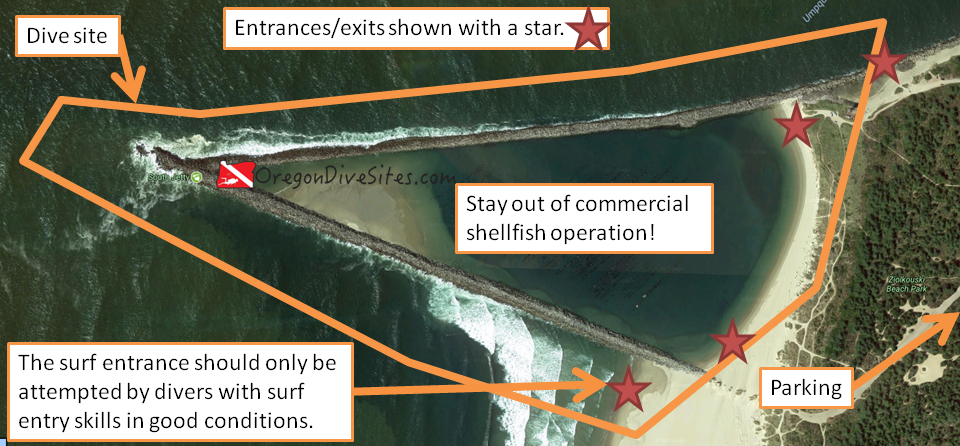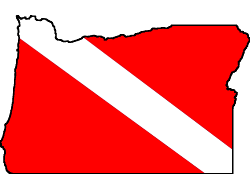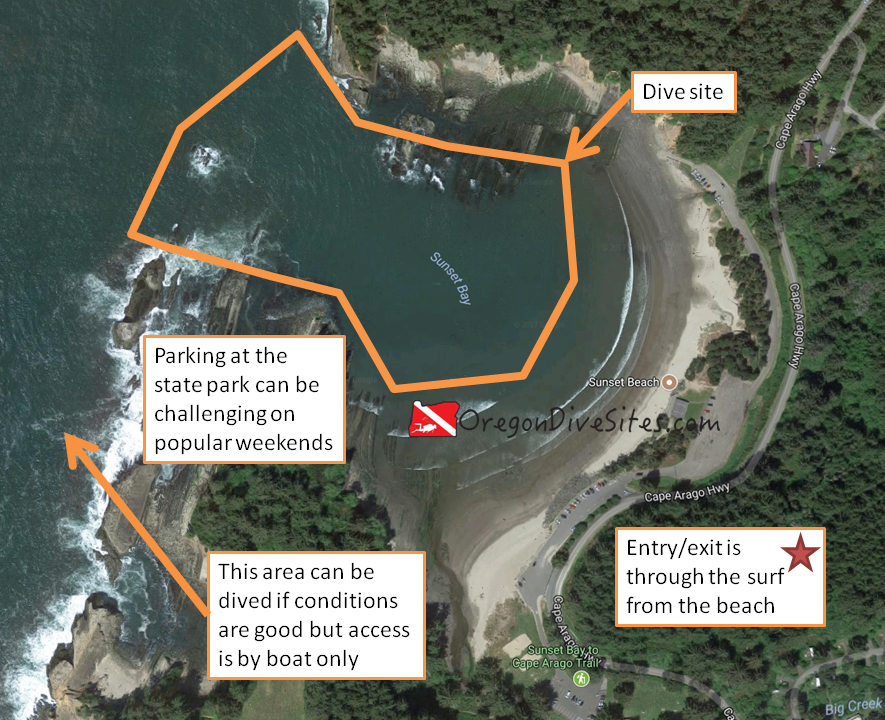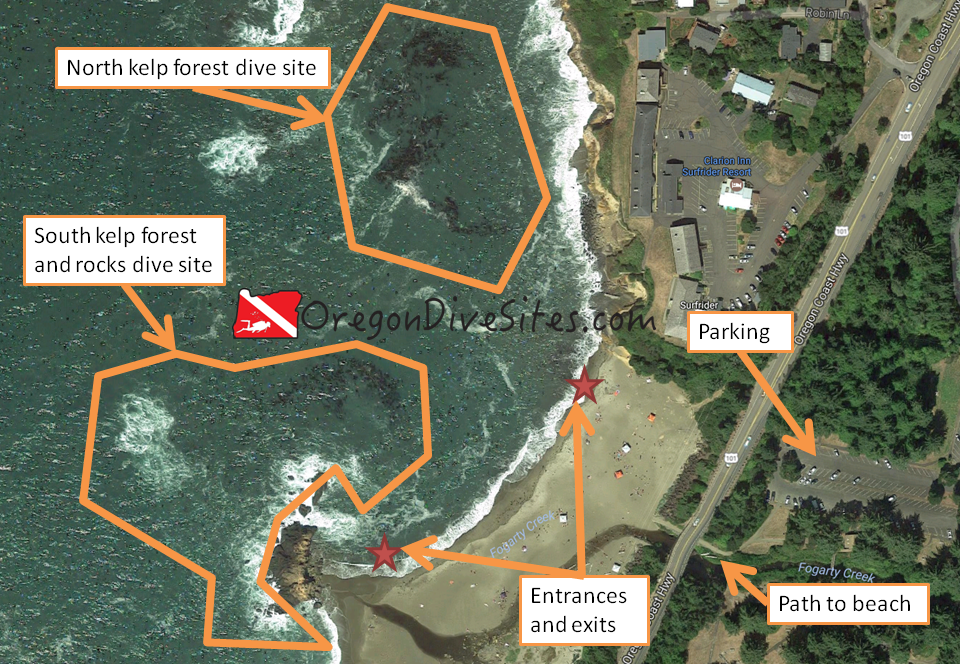The Umpqua River South Jetty and the area known as the Triangle Jetty just outside the town of Winchester Bay on the (unsurprisingly named) Winchester Bay is a great place to explore a unique jetty structure. Nowhere else that we know of along the coast in Oregon can you find a triangle jetty with water that is almost always calm even when the see is violently rough. It is important to note that the shellfish being commercially grown are strictly off-limits to recreational divers. It is a crime to attempt to harvest any of the shellfish. Don’t give other recreational SCUBA divers a bad name!

The Umpqua South Jetty and the area known as Triangle Jetty where commercial shellfish are grown is a good place to go dive in most ocean conditions. When the weather is rough, you can dive inside the triangle jetty. When it is good weather, you can dive on the outside of the jetty.
We can’t confirm it with our own eyes but based on videos we’ve found on YouTube, such as this one, it appears there is some sort of wreckage to discover along the jetty. We suspect this could be a small boat or maybe a rail car that fell off the tracks when the jetties were originally constructed. One way or another, we now have the triangle jetty and the whole south jetty complex on the Umpqua River on our short list of places to revisit in the very near future. If you have more information on this wreck, including location and what it might be, please comment below!
Nearest Town:
The nearest town is Winchester Bay. A little further inland is Reedsport, Oregon.
GPS Coordinates:
Special Directions to Site:
From the town of Winchester Bay, take Salmon Harbor Drive south and west.
Parking:
There are several locations that you can park at depending on how crowded it is and where you want to enter/exit. On the south jetty (north side of the dive site), you can drive right out along the jetty. We think that you can also drive along the beach here to access the triangle jetty area where the commercial shellfish are grown. There even appears to be access down to the south side of the triangle jetty. However, before you drive out onto the sand, double-check the local OHV laws and make sure you have an OHV sticker on your vehicle.
If you don’t want to get into the sand, there are day use parking areas along Salmon Harbor Drive.
Site Orientation:
There are three distinct areas on this dive site. The first that most people are the most interested in is the inside of the triangle jetty. This is an active commercial shellfish business area. Stay well clear of the shellfish platforms and hanging shellfish lines. There is risk of entanglement in all of the equipment used by the commercial operation. There may also be discarded shellfish lines underwater that you could become tangled in.
The second area is along the south side of the triangle jetty all the way out to the jetty tip where the south jetty reaches the sea and then partway along the inside of the south jetty. This area is often rough. Sea conditions usually preclude people from SCUBA diving here. However, there is generally good spearfishing and crabbing in this area.
The third area is along the eastern part of the south jetty in the Umpqua River channel. This area is usually pretty decent to dive and has decent spearfishing and crabbbing.
Entrances and Exits:
There are a multitude of entrance and exit options at this site. You can crawl over jetty rocks on the south jetty to gain entrance to the Umpqua River channel. You can practice your surf entrances/exits along the outer south side of the triangle jetty. You can do an easy beach entrance into the interior of the triangle jetty. This site has it all.
Please note that the surf entrance/exit can be dangerous and should only be attempted by divers who have sufficient training and experience. Conditions can rapidly change and make this an untenable entrance/exit. Have a backup plan!
Salt/Fresh:
This is a salt water dive.
Shore/Boat:
This is a shore dive.
Normal Conditions:
If you are inside the triangle jetty area, there is almost never any bad condition to find. The area isn’t even really impacted by tidal changes. No real current, almost never any surf or surge, and extremely rarely are there any waves in here. People can dive this area just about any time of the day or night and any day of the year.
Along the southern outside area of the triangle jetty, past the tip of the south jetty, and into the mouth of the Umpqua River, you will likely encounter surf, surge, current, and waves. Watch conditions closely if you are going to dive this area. There are only a few days a year that parts of this area is accessible.
On the inside of the south jetty in the Umpqua River channel, conditions are often better than on the outside of the jetties. However, you need to be cognizant of the current. Dive with the tide. In really bad weather, you can have surf, surge, waves, and related nastiness. In a worst case scenario, scratch a dive here and instead go dive the inside of the triangle jetty.
Normal Visibility:
Depending on the time of year and recent storms, you can range from 40 feet of viz off the tip of the south jetty on down to less than 5 feet of visibility along the outer south side of the triangle jetty. Usually though you’ll find 20-25 feet of vis.
Normal Temperature:
Water temperature varies between 48 and 60F depending on the time of year. If there has been recent snow that is melting in the mountains that feeds the Umpqua River, the river channel can be a bit colder.
Best Time of Year:
The inside of the triangle jetty can be dived any time of the year even in bad sea conditions (use common sense though!). The south jetty along the Umpqua River is good most of the year although when the upwelling happens over the summer, visibility isn’t amazing. The southern outside part of the triangle jetty is a very finicky place to dive and usually only will be accessible a few days a year in the summer.
Max Depth:
Off the tip of the south jetty, you can find up to 50 feet of water at high tide and with optimal bottom conditions. When sand moves around, you won’t find it that deep. In the triangle jetty, you’ll find maybe 25 feet of water but usually shallower unless there has been dredging recently. On the south side of the triangle jetty, you might find 30 feet of water.
Suggested Special Training:
Inside the triangle jetty, open water divers with some experience at other dive sites should have a good time. In some of the rougher areas outside of the triangle jetty and on the south jetty, the diving can become very advanced and challenging. Specific training in surf entry/exit is needed if you plan to do that.
Difficulty of Dive:
We rate this as an intermediate dive although if you try to dive the jetty tip or the exposed portions of the triangle jetty, you can find yourself in extreme or impossible conditions. Inside the triangle jetty there are entanglement hazards and machinery hazards so pay attention!
Distance of Walk to Entrance:
Depending on where you park and where you’re walking to, you will either walk 50 feet or up to 1000 feet.
Surface Swim Length:
No surface swim is needed at any of the areas in this site.
Special Site Notes:
Remember that it is illegal to interfere with the commercial shellfish operation. We know those oysters look tempting but DON’T DO IT! You will give SCUBA divers a bad name!
Closest Local Dive Shops to Get Air Fills and SCUBA Gear:
As of the time of writing this, there are no dive shops or air fill stations along the Umpqua River near Winchester Bay. There is (or at least was the last time we checked) a shop in North Bend to the south. Otherwise you’re looking at heading inland to Eugene. Check out the updated list of local dive shops in Oregon to see where the closest shop is to your dive.
Nearby Restaurants We Like:
There are a couple good restaurants in Winchester Bay and further inland at Reedsport.
Nearby Places to Camp and Diver-Friendly Hotels:
There is a campground right next to this dive site and several others in the immediate vicinity. In Reedsport there are the normal hotels although we haven’t tried any of them so we can’t comment on if they are friendly to SCUBA divers or not.
What Other People Have to Say About This Site:
Please write in the comments below your experiences with this dive site!


